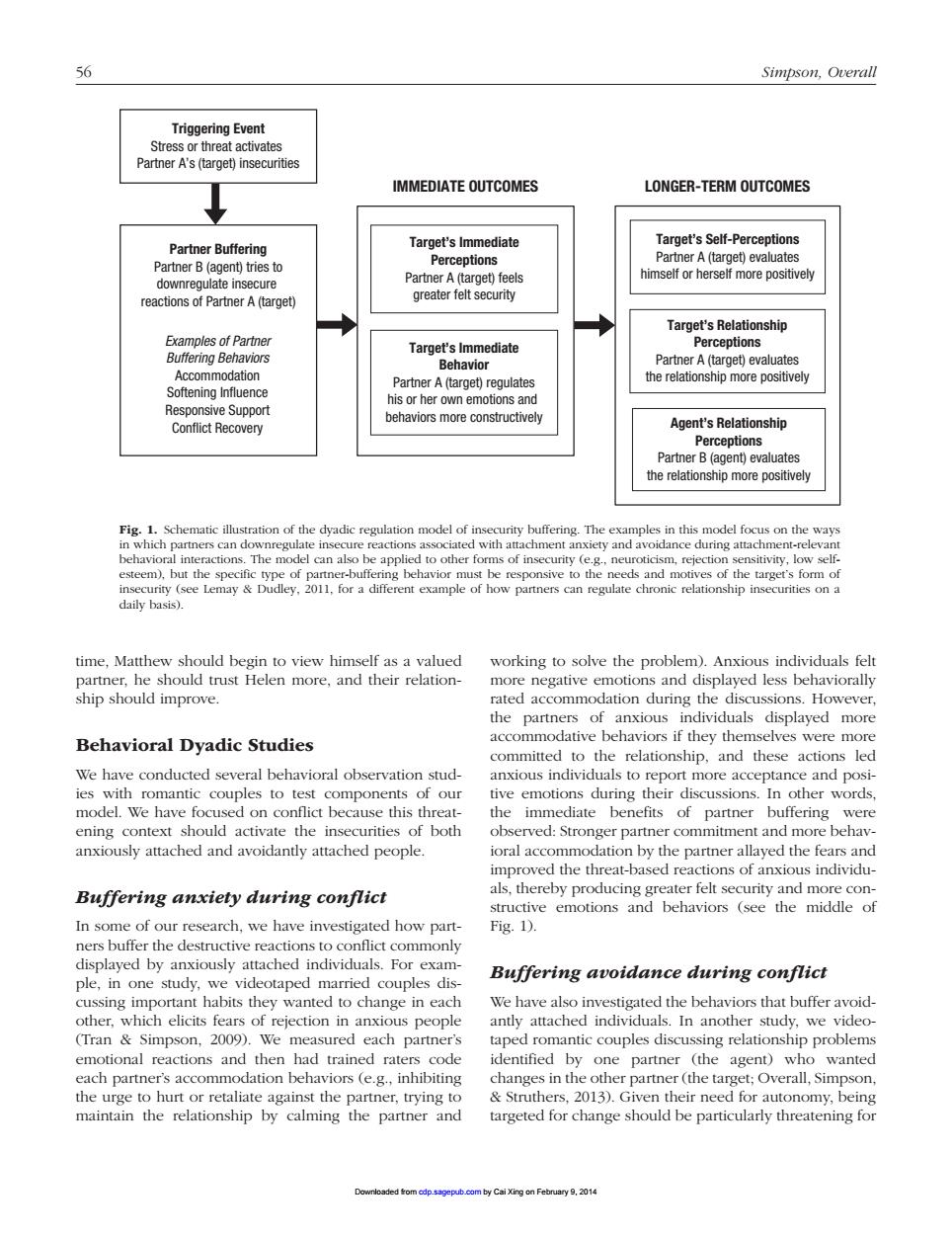正在加载图片...

56 Simpson,Overall Triggering Event IMMEDIATE OUTCOMES LONGER-TERM OUTCOMES Target's Immediate Target's Self-Perception himself or herself more postively reactions of Partner A(target) greater felt securiy Target's Relationship Target's Immediate Pariner A (target)evaluates PartnerA(ar the relationship more positively Agent's Relationship erceptions atic illustration of the dvadic re ation model of in n this s can beh n al d to other f of in sitivity,lo working to solve the problem).Anxious indi prove more neganve emonons and the partners of anxious individuals displayed more Behavioral Dyadic Studies accommodative behaviors if they themselves were more committed to the relationship.and these actions led servation stud report more acceptance and pos the immediate benefits of partner buffering were ening context should activate the insecurities of both observed:Stronger partner commitment and more behav anxiously attached and avoidantly attached people ioral accor lation by the partner allayed the fears and the thre t-Dased rea ons of anxious individu Buffering anxiety during conflict structive emotions and behaviors (see the middle of In some of our research,we have investigated how part Fig.1). displayed by ansiously attache als.For exam Buffering avoidance during conflict ortant habits they wanted to change in each We have also investigated the behaviors that buffer avoid other,which elicits fears of rejection in anxious people antly attached individuals.In another study,we video (Tran Simpson,2009).We measured each partner's taped romantic couples discussing relationship problems emotional reactions and then ntined by one partner (the agent)whe etaliate inst the a to maintain the relationship by calming the partner and targeted for change should be particularly threatening for 9.2014 56 Simpson, Overall time, Matthew should begin to view himself as a valued partner, he should trust Helen more, and their relationship should improve. Behavioral Dyadic Studies We have conducted several behavioral observation studies with romantic couples to test components of our model. We have focused on conflict because this threatening context should activate the insecurities of both anxiously attached and avoidantly attached people. Buffering anxiety during conflict In some of our research, we have investigated how partners buffer the destructive reactions to conflict commonly displayed by anxiously attached individuals. For example, in one study, we videotaped married couples discussing important habits they wanted to change in each other, which elicits fears of rejection in anxious people (Tran & Simpson, 2009). We measured each partner’s emotional reactions and then had trained raters code each partner’s accommodation behaviors (e.g., inhibiting the urge to hurt or retaliate against the partner, trying to maintain the relationship by calming the partner and working to solve the problem). Anxious individuals felt more negative emotions and displayed less behaviorally rated accommodation during the discussions. However, the partners of anxious individuals displayed more accommodative behaviors if they themselves were more committed to the relationship, and these actions led anxious individuals to report more acceptance and positive emotions during their discussions. In other words, the immediate benefits of partner buffering were observed: Stronger partner commitment and more behavioral accommodation by the partner allayed the fears and improved the threat-based reactions of anxious individuals, thereby producing greater felt security and more constructive emotions and behaviors (see the middle of Fig. 1). Buffering avoidance during conflict We have also investigated the behaviors that buffer avoidantly attached individuals. In another study, we videotaped romantic couples discussing relationship problems identified by one partner (the agent) who wanted changes in the other partner (the target; Overall, Simpson, & Struthers, 2013). Given their need for autonomy, being targeted for change should be particularly threatening for Partner Buffering Partner B (agent) tries to downregulate insecure reactions of Partner A (target) Examples of Partner Buffering Behaviors Accommodation Softening Influence Responsive Support Conflict Recovery Target’s Relationship Perceptions Partner A (target) evaluates the relationship more positively Target’s Self-Perceptions Partner A (target) evaluates himself or herself more positively Agent’s Relationship Perceptions Partner B (agent) evaluates the relationship more positively IMMEDIATE OUTCOMES LONGER-TERM OUTCOMES Target’s Immediate Perceptions Partner A (target) feels greater felt security Target’s Immediate Behavior Partner A (target) regulates his or her own emotions and behaviors more constructively Triggering Event Stress or threat activates Partner A’s (target) insecurities Fig. 1. Schematic illustration of the dyadic regulation model of insecurity buffering. The examples in this model focus on the ways in which partners can downregulate insecure reactions associated with attachment anxiety and avoidance during attachment-relevant behavioral interactions. The model can also be applied to other forms of insecurity (e.g., neuroticism, rejection sensitivity, low selfesteem), but the specific type of partner-buffering behavior must be responsive to the needs and motives of the target’s form of insecurity (see Lemay & Dudley, 2011, for a different example of how partners can regulate chronic relationship insecurities on a daily basis). Downloaded from cdp.sagepub.com by Cai Xing on February 9, 2014